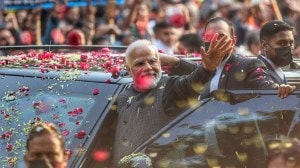Dabhol — Another version of reality
It was on the day that Enron first inked a Power Purchase Agreement (PPA) with the Sharad Pawar government for the first phase of its proj...

It was on the day that Enron first inked a Power Purchase Agreement (PPA) with the Sharad Pawar government for the first phase of its project in 1993, Enron’s chief negotiator and most visible face in India, Rebecca Mark, held a triumphant press conference for select journalists at a downtown hotel.
Those days, the single major allegation against Enron was that the rate of return it had bargained for itself was far higher than was permitted under existing laws. The liberalised power policy allowed a 16 per cent return on a 68.5 plant load factor (PLF) with a bonus for higher PLF specific approval of a financial package by the Central Electric Authority (CEA). But Enron’s project was negotiated and cleared outside this framework of existing laws and the estimates about its actual returns vary from 28-30 per cent or more. It was alleged that the costs would cripple the State’s electricity board and the allegation is part of today’s reality.
As far as I was concerned, everything else that the company had to say was not particularly relevant to a consumer paying for the power. The situation is no different today – its exact returns are still unknown. Dabhol Power Company’s (DPC) massive advertising campaign suggests a break from the past and an open-communication policy aimed at busting all the myths about the project. Hopefully the next advertisement will clear this mystery too. But let us look at what DPC has already said for itself. It claims that the cost of its power would be only Rs 4.02/kwh tariff at the contracted 90 per cent plant load factor (PLF). What is missing is the specific month to which this figure pertains. After all, by its own admission, the tariff varies every month based on fuel costs and the dollar rate. When its opponents claim that DPC’s power costs Rs 7.8/kwh its pertains to a specific month and DPC ought to provide similar figures for all the months that it has been in operation. Then again, DPC may make certain claims,but MSEB’s internal assessment of the tariff, which has been submitted to the Chief Minister is Rs 5.37/kwh at a 90 per cent PLF during phase II. Surely MSEB was a tacit supporter of the DPC deal?
Let us examine DPC’s claim that other projects, including public sector undertakings produce power at similar tariffs. Again there are no specific examples and hence no comparisons possible. Also why look at the padded up and high cost projects which were negotiated a la Enron? The comparison has to be with those projects which, even today are cheaper than DPC and have not demanded the same ironclad sovereign guarantees negotiated by it.
In fact, let us look at why Enron carries the can for the distortion of the power sector not only in Maharashtra but in the rest of the country. DPC’s project has built in costs such as the fixed capacity charge, pass through charges for fuel and foreign exchange conversion and in-built accelerators for O&M charges, inflation, heat rates and high fuel management fees were never even imagined in the Indian context. When it became clear that politicians and bureaucrats expensively "educated" by Enron were lobbying hard to allow such cost, even private companies quickly spun off their captive power units into Independent Power Projects (IPPs) and trebled costs under cover of increasd capacity. The high costs of other projects cited by the DPC advertisement are a post-Enron phenomenon and modeled entirely on DPC but within the framework of the power tariff laws.
The next question is, will Enron’s tariffs continue to increase in future? The DPC advertisement says "on the contrary" but makes no assurance of a reduction in tariff. The fact is that it cannot make such claims. As the advertisement admits – even after the change in fuel to LNG – its tariff will depend entirely on 90 per cent offtake, foreign exchange rates and international crude oil costs remaining within $ 21-28. Most of us know that ever since 1993, Enron has used the uncertainty of these variable pass through charges to confidently claim that that its power would only be marginally higher than existing projects and no more than Rs 2.10-Rs 2.30 per kwh. Newspaper clippings with those claims are available with most journalists who have followed the fate of the project over the years.
Even until recently DPC India’s chairman Sanjay Bhatnagar had claimed that the cost of power during Phase II would be Rs 2.45/kwh. What then is the credibility of its "to the contrary statement"? Finally, the real question is whether Maharashtra needs Dabhol power? The reality is that it does not. The State cannot afford Dabhol power, especially after Phase II is complete. Further, MSEB’s own Uran project has 500 mw of capacity has been deliberately kept idle and will supply power at a vastly lower rate than Enron. If this is commissioned immediately then Maharashtra certainly does not need Dabhol power in the foreseeable future.
More pertinently the power shortage figures put out by the States also seem vastly exaggerated. Nobody even knows what is the true shortage and even Dabhol’s advertisement derives its numbers from a newspaper and not the MSEB or the State government. In fact, many of us believe that the State projected a huge shortage only to justify the trebling of the DPC project to 2184 mw. In fact, two petitions have been filed charging that the shortage projected by the State is artificial. One of these has been filed by the activist S R Paranjape before the Maharashtra Electricity Regulatory Commission (MERC) and another by the Vidharba Industries Development Association before the Nagpur High Court bench.
Also, setting up expensive new plants can never be the answer when transmission and distribution losses are as high as those of MSEB (38 per cent). If these losses which are merely an euphemism for large-scale theft are reduced, the shortages will disappear and MSEB’s financial health will also improve.
Author’s email: suchetadalal@yahoo.com
Photos


- 01
- 02
- 03
- 04
- 05





























